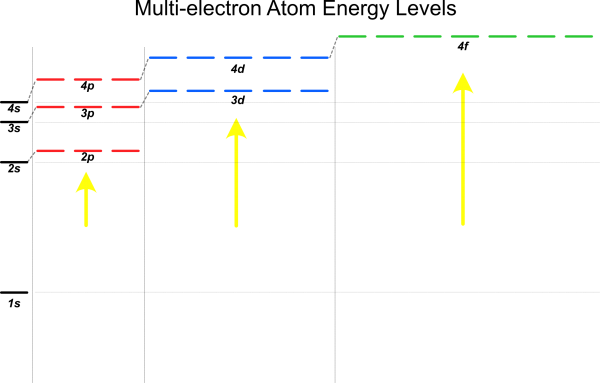Difference between revisions of "Ch7 Lec 5"
| Line 44: | Line 44: | ||
Below are the helium electron energy levels with 2 electrons...note that there is a red and blue electrons denoted by a half-arrow: | Below are the helium electron energy levels with 2 electrons...note that there is a red and blue electrons denoted by a half-arrow: | ||
| − | ::- the red electron is "spin up" assigned an | + | ::- the red electron is "spin up" assigned an ''m<sub>s</sub>'' = +1/2 |
| − | :: - the blue electron is "spin down" assigned the | + | ::- the blue electron is "spin down" assigned the ''m<sub>s</sub>'' = -1/2 |
| + | ::- the '''''electron configuration''''' is abbreviated as 1s<sup>2</sup> <--this means the 1s orbital has "2" electrons in it. | ||
<div align="center"> | <div align="center"> | ||
| − | [[File:energy_level_06_He.png| | + | [[File:energy_level_06_He.png|600px]] |
</div> | </div> | ||
Revision as of 18:45, 27 April 2020
(4/27/20, bes)
Welcome to your afternoon lecture...as opposed to online..."lab"...as always...please take notes (no need to turn anything in), the WA will test your understanding...
Atomic Orbitals
Here is a slightly different version of the hydrogen atom energy level diagram. As you will recall, this idea of "quantized" energy levels was a result of some experiments that resulted in the formulation of quantum mechanics. The electron exists in the lowest energy state, the 1s orbital, unless this electron is excited to higher energy levels.
In the following version of the energy level diagram, i have places a few "excited" electrons...complete the following table to identify the quantum numbers with each of these electrons.
| color | n - principal | l -angular | ml - magnetic | 'ms - spin |
| purple | ||||
| orange | ||||
| green | ||||
| red |
Multi-electron Energy Levels
The hydrogen atom is special in that it only contains 1 electron. When a second electron (or more) is added into the atom, there is a BIG change in the energy levels. Below is the energy level diagram for a multi-electron system...note the following:
- 1) relative to the s-orbitals, the p-orbital energy levels is shifted up,
- 2) relative to the p-orbitals, the d-orbital energy levels are shifted up,
- 3) relative to the d-orbitals, the f-orbital energy levels are shifted up,
Electron Configuration
It is best to keep the above picture of the multi-electron energy level diagram in your "head." Let's start to discuss how the electrons are placed into these energy levels..
2-electrons or Helium
Keep in mind that electrons are lazy...they prefer to be in the lowest energy state. So for a 2-electron system (aka He) on first observation you might suggest that electron 1 be placed in to the 1s orbital and then electron 2 be placed in the next orbital, 2s orbital. Well...as you probably know (if you took chem in high school) that each orbital can contain 2 electrons. The first problem that arises from having 2 electrons in the same orbital is that you cannot specifically distinguish the electrons from each other using quantum numbers...
- n = principal quantum number
- l = angular momentum quaantum number
- ml = magnetic quantum number...and now...we add a 4th Q#...
- ms= spin quantum number.
Below are the helium electron energy levels with 2 electrons...note that there is a red and blue electrons denoted by a half-arrow:
- - the red electron is "spin up" assigned an ms = +1/2
- - the blue electron is "spin down" assigned the ms = -1/2
- - the electron configuration is abbreviated as 1s2 <--this means the 1s orbital has "2" electrons in it.



